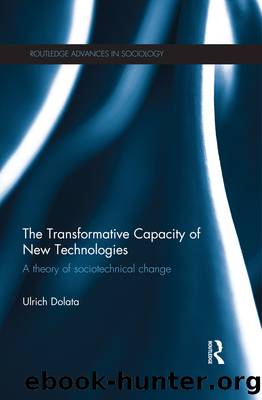The Transformative Capacity of New Technologies by Ulrich Dolata

Author:Ulrich Dolata [Dolata, Ulrich]
Language: eng
Format: epub
ISBN: 9781138807846
Barnesnoble:
Publisher: Taylor & Francis
Published: 2014-07-04T00:00:00+00:00
6 New Technologies and Sectoral Transformation
6.1 Transformative Capacity, Adaptability, and Gradual Transformation
The two concepts â the transformative capacity of new technologies and sectoral adaptability â enable technology-induced change to be empirically portrayed and theoretically explained as an iterative interplay between technological dynamics and associated socioeconomic and institutional restructuring.
The concept of transformative capacity focuses on technology as an important factor influencing sectoral change. The peculiarities of new technologies exert distinct pressures of change onto sectors, their structures, institutions, and actors. However, the transformative capacity of new technologies leads neither directly nor deterministically to clear-cut organizational, structural, and institutional changes. The ways in which the pressure to adjust and to change is handled and reflected in new organizational, structural, and institutional arrangements concern genuine actor-based processes of search, selection, and readjustment, processes which are framed by the socioeconomic structures and institutions that exist in each case. Therefore, to obtain a full picture of technology-induced change requires the transformative capacity of new technologies to be combined with the adaptability of sectoral structures, institutions, and actors. By means of the complementary concept of adaptability, we can identify different variants of sectoral perception and handling of major technological challenges and distinguish different paths of technology-induced sectoral transformation. Transformative capacity and adaptability go hand in hand; the concepts do not function in isolation.
A third aspect also requires consideration. Whatever variant of technology-induced sectoral transformation occurs, it proceeds not as an abrupt and eruptive socioeconomic break quickly followed by a new phase of stability with only marginal processes of further adjustment. Existing technologies, structures, institutions, and actors do not generally undergo sudden collapse or radical replacement. More typical are longer phases of mismatch and renewal. These may take from one to several decades, during which a sector gradually moves toward a new sociotechnical match that is repeatedly challenged from ongoing technological innovations.
Two reasons exist for these extended periods of transformation. Even when radically new technologies have reached a point where they are applicable, they remain incomplete and malleable over longer periods of time. It is often initially unclear how new technological opportunities can actually be used. They are experimented with, searches take place on how the new technologies may be implemented and applied, with the technologies then being subject to further modification or major overhaul. During this process they compete with the technologies in current use, which are often also capable of undergoing further development. Established technologies are therefore generally not simply replaced by new ones. If new technologies are to gain in importance, and develop from niche technologies to effective alternatives that can change a sectorâs technological profile, then they do so gradually and after multiple processes of search and selection (Levinthal 1998; Geels and Kemp 2007).
The same applies to the accompanying processes of socioeconomic and institutional change. Organizational restructuring, triggered by new technological opportunities, occurs as a tentative and gradual process, as does the emergence of new areas of business and the major realigning of production, marketing, and R&D activity. Existing market and competitor constellations also change successively rather than abruptly.
Download
This site does not store any files on its server. We only index and link to content provided by other sites. Please contact the content providers to delete copyright contents if any and email us, we'll remove relevant links or contents immediately.
| Automotive | Engineering |
| Transportation |
Machine Learning at Scale with H2O by Gregory Keys | David Whiting(4172)
Never by Ken Follett(3788)
Urban Outlaw by Magnus Walker(3338)
OPNsense Beginner to Professional by Julio Cesar Bueno de Camargo(3249)
Sapiens and Homo Deus by Yuval Noah Harari(2986)
Will by Will Smith(2790)
A Short History of Nearly Everything by Bryson Bill(2629)
Hooked: A Dark, Contemporary Romance (Never After Series) by Emily McIntire(2496)
Rationality by Steven Pinker(2290)
Borders by unknow(2227)
Holy Bible (NIV) by Zondervan(2086)
The Becoming by Nora Roberts(2085)
The One Percenter Encyclopedia by Bill Hayes(1787)
HBR's 10 Must Reads 2022 by Harvard Business Review(1776)
Freedom by Sonny Barger(1770)
A Short History of War by Jeremy Black(1758)
Five Ways to Fall by K.A. Tucker(1697)
Go Tell the Bees That I Am Gone by Diana Gabaldon(1685)
Girls Auto Clinic Glove Box Guide by Patrice Banks(1683)
